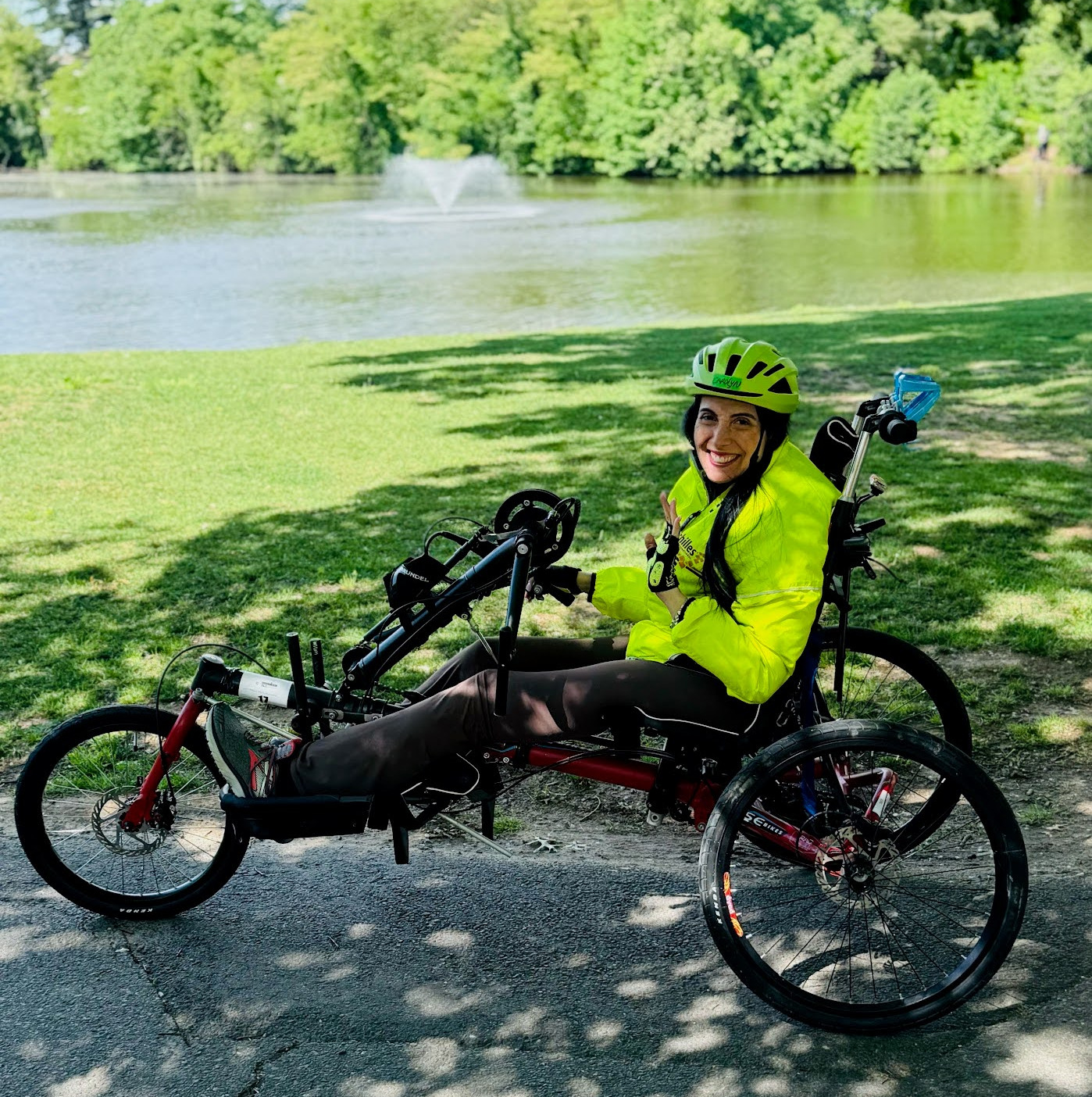Handcycle powers MS woman’s journey toward self-discovery
New Yorker aiming to complete 3 races in Central Park in 60 days

Carolyn Cannistraro is aiming to complete three races across New York City within 60 days using a handcycle. (Courtesy of Carolyn Cannistraro)
For many years after being diagnosed in 1992 with relapsing-remitting multiple sclerosis (MS), Carolyn Cannistraro didn’t want to think about having MS, let alone tell others about her condition.
But now Cannistraro is aiming to complete three races across New York City within 60 days using a handcycle. She is hoping her quest will encourage others with MS to embrace their journey by living full “unleashed” lives.
Cannistraro began using a handcycle, which is an adapted bike that is powered by the arms instead of the legs, in races about a year ago.
“It’s a great solution for people with lower limb challenges,” says Cannistraro, who works as a financial planner.
Crossing the finish line
In late April, Cannistraro completed the 13.1-mile 2025 Maybelline Women’s Half, a half-marathon that took place in New York City’s Central Park, with a time of 2:40:06. She and one other handcyclist were among the more than 5,000 overall race finishers.

Carolyn Cannistraro and her guides pose for a photo at the Maybelline Women’s Half race. (Courtesy of Carolyn Cannistraro)
She now plans to participate in two more Central Park races in June: the Mastercard NY Mini 10k race and the Achilles Hope & Possibility, an inclusive race for the disability community.
“It’s about the spirit of sportsmanship and achieving a goal,” Cannistraro says.
Cannistraro, who lives in Westchester County, New York, prepares for her races by going to the gym and practicing on a high school track. She also uses the handcycle as part of her physical therapy to improve her upper body strength.
When she is competing, one or two guides are typically assigned by the race organizers to run with her, mostly to make sure she has a clear path.
Though Cannistraro never aspired to participate in marathons or other races, she was athletic as a child and is also a ballroom dancer. About 10 years ago, a friend who was a runner connected her with Achilles International, an organization that uses athletics to try to help change the lives of people with disabilities.
Shortly after, Cannistraro was invited to an Achilles dinner. At the time, she was wearing a leg brace, but still hadn’t fully accepted her MS diagnosis and felt she would be out of place.
“I was like, I don’t have that, really,” she says. “But I went, and I found myself. I didn’t want to admit another layer of self-disclosure that I really do have this.”
A long road to acceptance
Cannistraro’s MS journey began when she was a student at Boston College and awoke one morning without any feeling in one of her arms.
Cannistraro, who favors high-heel shoes, recalled going to a department store after her diagnosis and sitting in a shoe section, tears falling, as she watched women try on shoes she believed she would never wear again.
“I knew that the whole world for me, my feminine world, was shattered,” says Cannistraro, who can only wear shoes with laces so as to keep her foot secured in a shoe brace. She’s used the brace since 2013 to help with balance.
When Cannistraro began working on Wall Street as a senior financial advisor, her primary MS symptom was chronic numbness in her hands and feet. She learned to hide the sensory changes by walking more slowly and deliberately in low-heeled shoes, her eyes trained on the ground. Still, she had difficulty feeling her feet in her shoes and her gait caused back pain, which she handled in silence.
“I didn’t even want to think about it,” she says. “I wanted to live my life as normally as possible. I wanted to be a young person doing young person things.”
But Cannistraro felt isolated and alone. In retrospect, she said that was probably the wrong approach.
“I think I ran the risk of people not knowing me,” she says. “Looking back, I encourage people to come clean with it.”
Cannistraro began her current position with Wells Fargo nearly five years ago, after realizing that she needed accommodations. She said she didn’t know whether they would hire her, but that she knew she had to speak up and tell them what she was going through.
“It’s a psychological journey that we go on,” Cannistraro says.
Encouraging others to ‘be their own champion’
Cannistraro talks publicly about her marathons — last year, she completed the 26.2-mile TCS New York City Marathon on her handcycle, finishing in 6:01:09 — as a way to encourage others and to continue her evolution toward acceptance of her condition.
“I think that by sharing my story, vocalizing my story, I can no longer pull the wool over my own eyes,” she says. “But I also want to make a difference.”
While her arms hurt a bit while racing, she says she is usually fine afterward. Cannistraro injects an interferon treatment three times weekly, occasionally takes a muscle relaxer for back pain, and has some vision issues.
“People can get out and live their life and go beyond what they think is, or experience as, a limitation. I encourage people to get support,” Cannistraro says. “You don’t have to be alone with it. You can have a team around you. Anything is possible. It starts with a statement, a declaration, then you have to trust yourself and the process.”
These days, Cannistraro is more forthcoming about her MS experience, drawing support from others with the disease and from organizations such as the National MS Society.
“I just want to encourage other people to be their own miracle and their own champion, “ Cannistraro says. “That’s the adventure I’m on.”








